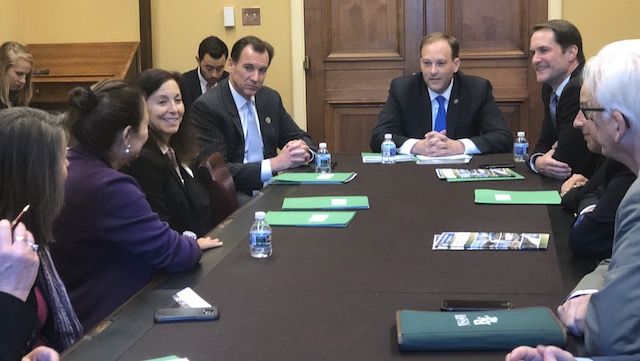New York and Connecticut Long Island Sound stakeholder groups headed to Washington, D.C. to meet with U.S. Senate and Congressional leaders over the Thanksgiving holiday to present three critical messages: (1) Increase funding for Long Island Sound Program to $20 million; (2) Preserve Plum Island for future generations; and (3) Increase federal funding for both drinking and waste water infrastructure.
There were numerous participating groups involved including Citizens Campaign for the Environment, Supervisor of Town of Mamaroneck, Save the Sound, Coalition to Save Hempstead Harbor, Hempstead Harbor Protection Committee, Long Island SoundKeeper, Cold Spring Harbor Whaling Museum and Education Center, Friends of the Bay, Construction Industry Council of Westchester and Hudson Valley, Long Island Sound Funders Collaborative, Preserve Plum Island Coalition, The Nature Conversancy, Audubon NY, REI, Sierra Club, Nassau Soil and Water Conservation, and Sound School Regional Vocational Aquaculture Center.
These groups urge preservation. The Long Island Sound is an Estuary of National Significance that “generates between $17-37 billion annually to the regional economy. The Long Island Sound Study is part of the EPA’s National Estuary Program which allocates funding to 28 estuary programs across the nation each year. Congress based a budget that included record funding of $12 million for the Long Island Sound program in 2018. These funds are leveraged with local, county, and state resources to fund critical programs to preserve land, restore habitat, improve water quality and enhance stewardship areas around the Sound.” Additionally, although President Trump’s annual policy budget routinely eliminates the Sound program “Plum Island is a mostly undisturbed 800-acre Island in the Sound, in which the federal government is mandated to sell.”
Adrienne Esposito, Executive Director of Citizens Campaign for the Environment (CCE), advised that the 24 attendees left Long Island around 3:00 a.m. for a long drive and day in our nation’s capital, returning to Long Island around 1:00 a.m. Encouraged, the group was able to meet directly with Senators Schumer and Blumenthal, with the staff for Senators Gillibrand and Murphy, and with Congressmen Zeldin, Suozzi, Engel and Courtney.
 |
|
Congressman Zeldin, Congressman Suozzi, and Congressman Joe Courtney from Connecticut met with the stakeholders. (Courtesy Photo) |
Esposito revealed, “This was a really positive trip, and the fact remains that decisions are made in DC by people who show up. We asked for $20 million for Long Island Sound, as the current budget allocates $12 million, which is an increase from the original $3 million so this was a really worthy endeavor. For the $2.3 billion allocated for sewers and drinking water, we asked that it be doubled to $5 billion. We also asked for a senatorial legislative hearing regarding Plum Island to highlight it as a national treasure in order to prevent it from being sold.”
Continuing Esposito said, “Senators Blumental loved the idea of a hearing, as did the staff for Senator Gillibrand.”
When asked about the future of these requests, Esposito responded, “We will continue our work on negotiations for the budget and to have our funding requests fulfilled, particularly the preservation of Plum Island.”
The Long Island Sound Study that has brought together stakeholders from New York and Connecticut has resulted in the successful bi-state restoration effort which has been on-going for over 20 years. “The program has restored 1,750 acres of habitat and tidal wetlands, opened more than 350 river miles for migratory fish to travel between the brackish Long Island Sound waters and upstream freshwater rivers and lakes, reduced nitrogen pollution entering the Sound by 42 million pounds annually, and vastly improved both water quality and the health of local fisheries.”
These “Federal funds are used to reopen fish passages, restore and protect coastal habitats and wetlands, replant seagrass, ensure critical scientific research, and improve water quality. Funds are also used to protect, and enhance upland sites within the Long Island Sound ecosystem with significant ecological, educational, open space, public access, or recreational value. Federal dollars are stretched even further with matching local, state and private dollars. The Long Island Sound Restoration and Stewardship Act is authorized at $65 million a year. The Long Island Sound Restoration and Stewardship Act monies represent the backbone to the entire protection and restoration program for the Sound.”
For more information go to www.saveplumislandny.org, or www.citizenscampaign.org.












